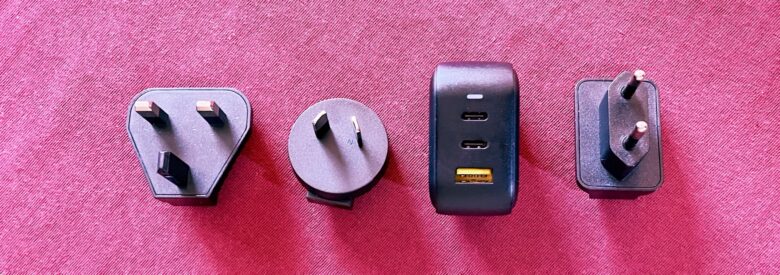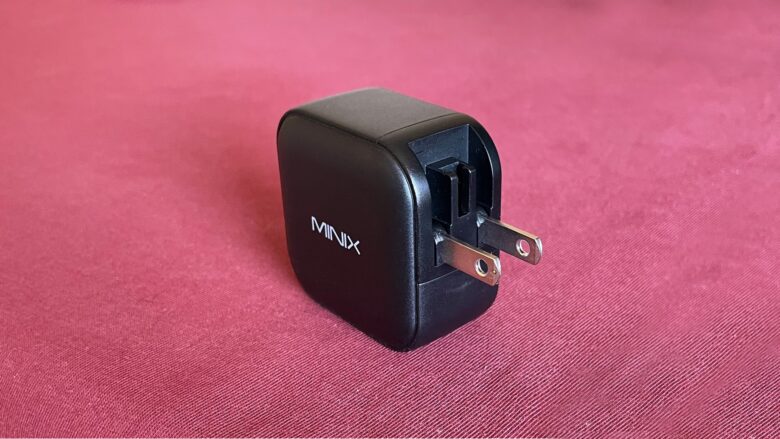The Minix Neo P1 uses gallium nitride to pack three powerful USB ports into a tiny wall charger. It can provide up to 66W to an iPhone, Mac, iPad, Apple Watch or other gear. And the power adapter is made for travel, with fold-down prongs and adapters for a wide variety of countries.
I tested the Neo P1 with a variety of devices. Here’s how it stood up.
This post contains affiliate links. Cult of Mac may earn a commission when you use our links to buy items.
Minix Neo P1 review
This charger is a solution for the problem Apple gave iPhone 12 users. The handset comes with a Lightning-to-USB-C cable, but no wall charger. The Minix Neo P1 could fill in for the missing iPhone charger.
But that’s just the start. It has a second USB-C port, and a USB-A too. So while your handset is getting power, your MacBook and Apple Watch can juice up, too. And all of this comes in a unit that’s Lilliputian compared to Apple’s single-port MacBook charger.
Hardware and design
The Minix Neo P1 looks a lot like the old iPad charger, but with 3x the ports and a lot more power capacity.
The charger measures 2.0 inches by 2 inches and 1.4 inches thick, and weighs 0.25 pounds (4 ounces). It goes easily into a bag or purse, but isn’t particularly pocketable.
Minix used gallium nitride semiconductors in place of silicon because GaN is much more efficient. That’s why this power adapter can outperform any charger Apple makes.
The exterior is black polycarbonate plastic. Utilitarian, but this is a tool, not an ornament.
Ports
On the front of the Neo P1 are the two USB-C ports. Each of these can put out a maximum of 65W. And they support the Power Delivery 3.0 standard for quicker charges.
Also on the front is a USB-A port, which supports Quick Charge 3.0, but that’s not a standard Apple adopted. Many Android phones use it, though.
It’s important to remember that the Neo P1 can put out 66W at most. So if a single MacBook is plugged in, it’ll receive 65W. But add a second MacBook and each will receive 33W. Add a third device to the USB-A port, and the power going to the two MacBooks must drop further.
Electrical socket adapters

Photo: Ed Hardy/Cult of Mac
Built into this charger is a pair of fold-down Type A prongs for use in North America. But Minix doesn’t stop there. The Neo P1 includes clip-on adapters for the EU (Type C), UK (Type G) and Australia (Type I).
The adapters slide on over the U.S. prongs, and are easy to attach and remove.
Performance
I put the Minix Neo P1 through real-world testing by having it charge an iPhone 12 (not Pro or mini). Half an hour connected to one of the USB-C ports raised the handset’s battery level by 53%. In an hour, the battery level rose to 84%. That’s the same rate I get with other chargers, indicating the Neo P1 is juicing up the iPhone as quickly as possible.
I also tested the charger with a 12.9-inch iPad Pro (2020). Half an hour of charging brought the battery level up 31%.
The USB-A port isn’t any slouch either. I connected it to an iPhone 11 for half an hour and it brought the battery level up 39%.
Part of testing included simultaneously hooking up a tablet and two batteries to check the temperature of the unit. It got warm during this stress test, but never hotter than that.

Photo: Ed Hardy/Cult of Mac
Minix Neo P1 final thoughts
Chargers built with gallium nitride make the silicon-based ones we had to use years ago seem Brobdingnagian. The Minix Neo P1 is a brilliant example of what’s possible. It packs three useful ports into a unit that’s easily portable.
I’m putting the Neo P1 in my gear bag, where it’ll save space by replacing several other chargers.
Pricing
Minix distributes its products through Amazon, where the Neo P1 currently costs $34.90.
Buy from: Amazon
For comparison, the Apple 30W USB-C Power Adapter costs $49, and doesn’t offer a USB-A port. The Ravpower PD 30W USB-C Charger is about the same size as the Neo P1, and it offers a USB-C port and a USB-A one. Plus, it comes with a Lightning-to-USB-C cable. It sells for $24.99.
Minix provided Cult of Mac with a review unit for this article. See our reviews policy, and check out more in-depth reviews of Apple-related items.
![This tiny charger powers Mac, iPhone and Apple Watch at once [Review] Minix Neo P1 review](https://www.cultofmac.com/wp-content/uploads/2020/12/77DBBCBE-9776-4CCF-B280-5C690AFC1865-1536x864.jpeg)

